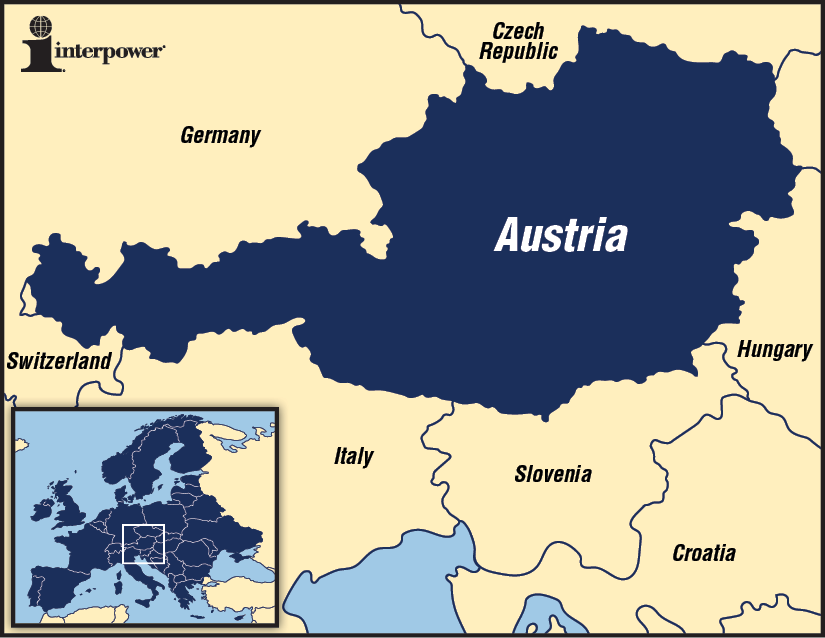Exporting to Austria

| AUSTRIA | |
|---|---|
| Actual population* | Population world ranking |
| 8,223,062 | 95 |
| Actual GDP (PPP)* | GDP world ranking |
| $361 billion | 38 |
| Actual GDP (per capita)* | GDP (per capita) world ranking |
| $42,600 | 22 |
*See the end of this blog for definitions
Austria plays a key part in the global market as it offers strong trading opportunities, a well-diversified economy, and favorable economic conditions. This country can also serve as a link between western and eastern European markets.
To enter the Austrian market, a suggested entry strategy is to choose a local distributor or agent with market awareness and a network of connections and to make personal visits. Since Austria is a member of the European Union, it is essential to make sure all agreements are in accordance with EU and member state laws. A number of organizations, such as the United Nations, have their headquarters in Austria, as do many other internationally-based companies. Austria’s location also allows the opportunity to reach a large number of consumers in the region.
Discover what the business customs of Austria are. The business environment tends to be relatively formal. Learn what is expected when making appointments, the proper way to greet people, and the proper way to use titles in a person’s name. Research how Austrians tend to view the buyer-seller relationship and what is accepted in sales approaches. Showing awareness of the Austrian way of life can help to enhance the success of doing business in that country.
To assist with market research, market entry strategies, business customs, and import/export requirements, there are a number of resources to consult, including the United Kingdom Trade and Investment, the United States Commercial Service, and the Wirtschaftskammer Österreich (Austrian Economic Chambers).
Located in Western Europe, Austria joined the European Union in 1995. The EU is a Customs Union which consists of member countries who have formed a single region for customs purposes. Goods that have been imported legally can circulate throughout the EU with no further customs checks. To learn more about the customs regulations, among the sources to consult are the European Commission Export Helpdesk and European Commission Taxation and Customs Union. Conducting due diligence in accordance with all of the regulations is essential.
Some products may require safety testing and certification for this market. While not all products are required to have a CE mark, others do require one. When affixing the CE mark to a product, a manufacturer affirms that the product meets the necessary requirements and can be sold throughout the EU.
There are also EU regulations that need to be followed, so it’s important to know what is required in Austria. Among them are:
- REACH is the European regulation for Registration, Evaluation, Authorization, and Restriction of Chemicals. The European Commission works closely with ECHA (European Chemicals Agency) in the implementation of this regulation.
- RoHS stands for Restriction of Hazardous Substances. It restricts the use of certain hazardous materials found in electrical and electronic products.
- WEEE stands for Waste from Electrical and Electronic Equipment. WEEE requires the treatment, recovery, and recycling of electric and electronic equipment.
German is the official language of Austria. While English is spoken by many within the business community, it is recommended to have product literature and correspondence be in German.
In Austria, the voltage used is 230V at 50Hz. The most frequently specified plug pattern is the Continental European plug.
Sources
www.export.gov/austria
www.gov.uk
www.wko.at
Sources for European Union
www.ec.europa.eu
www.echa.europa.eu
www.rohsguide.com
www.exporthelp.europa.eu
www.europa.eu
www.export.gov/europeanunion
*Source: www.cia.gov/library/publications/the-world-factbook/index.html
Country comparison—Population: Population compares estimates from the US Bureau of Census based on statistics from population censuses, vital statistics, registration systems, or sample surveys pertaining to the recent past and on assumptions about future trends. (July 2014 est.)
Country comparison—GDP (Purchasing Power Parity): GDP (purchasing power parity [PPP]) compares the gross domestic product (GDP) or value of all final goods and services produced within a nation in a given year. A nation’s GDP at PPP exchange rates is the sum value of all goods and services produced in the country valued at prices prevailing in the United States. (2013 est.)
Country comparison—GDP – per capita (PPP): GDP – per capita (PPP) compares GDP on a purchasing parity basis divided by population as of 1 July for the same year. (2013 est.)






